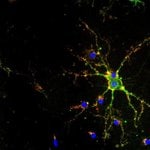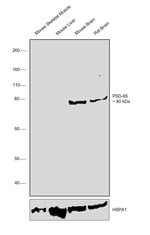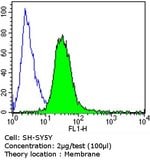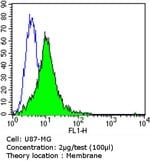Learn More
Invitrogen™ PSD-95 Monoclonal Antibody (7E3-1B8)
Mouse Monoclonal Antibody
Marke: Invitrogen™ MA1046
699.20 CHF gültig bis 2025-08-22
Benutzen Sie den Promotions-Code "24148" um Ihren Promotions-Preis zu erhalten.
Beschreibung
MA1-046 detects post synaptic density 95 (PSD-95) from human, rat, xenopus laevis and mouse tissues. MA1-046 has been successfully used in Western blot, immunofluorescence, immunocytochemistry, immunohistochemistry, flow cytometry and immunoprecipitation procedures. By Western blot, this antibody detects an ~95 kDa protein representing PSD-95 from rat brain extracts. Immunofluorescence staining of PSD-95 in rat hippocampal cells with MA1-046 yields a staining pattern coincident with NMDA receptor. In immunofluorescence staining, fixation with cold methanol is recommended. The MA1-046 immunogen is purified recombinant rat PSD-95. This antibody was orginally validated as part of a Thermo Scientific Cellomics High Content Screening Kit. The antibody sold separately may have slightly different performance and may need to be further optimized for the best results.
Post Synaptic Density 95 kDa (PSD-95), also known as synapse associated protein 90 kDa (SAP90), is one of a family of membrane-associated proteins found in the postsynaptic density in forebrain neurons and certain presynaptic structures in the cerebellum. Like other members of the family, PSD-95 has three 90 amino acid repeats called PDZ domains followed by an SH3 domain and a yeast guanylate kinase homology (GuK) domain. PSD-95 is believed to participate in the clustering of certain proteins, including NMDA receptors, Shaker-type potassium channels at the synaptic membrane in central nervous system (CNS) neurons. There are two principal modes of interaction between PSD-95 and other proteins. NMDA receptors and shaker-type potassium channels both share C-terminal sequence homology consisting of a threonine/serine-X-valine-COOH (T/SXV) motif. Other neuronal proteins that share this motif (beta 1 adrenergic receptor, some serotonin receptors, some sodium channel subunits, and additional potassium channel subunits), and some of these proteins may interact with PSD-95 by binding to its PDZ domains. Neuronal nitric oxide synthase (nNOS), which lacks the T/SXV motif but which has its own PDZ domain, has been shown to associate with PSD-95 in vitro through a pseudo-homotypic PDZ-PDZ interaction.
Spezifikation
| PSD-95 | |
| Monoclonal | |
| 1 mg/mL | |
| PBS with 0.05% sodium azide | |
| P31016, P78352, Q62108 | |
| DLG4 | |
| Purified recombinant rat PSD-95. | |
| 100 μL | |
| Primary | |
| Human, Mouse, Rat, Frog | |
| Antibody | |
| IgG1 κ |
| Flow Cytometry, Immunohistochemistry (Frozen), Immunoprecipitation, Western Blot, Immunocytochemistry | |
| 7E3-1B8 | |
| Unconjugated | |
| DLG4 | |
| discs large homolog 4; discs large MAGUK scaffold protein 4; discs, large homolog 4; discs, large homolog 4 (Drosophila); disks large homolog 4; Dlg4; Dlgh4; FLJ97752; FLJ98574; post synaptic density; postsynaptic density protein 95; post-synaptic density protein 95; PSD95; PSD-95; PSD-95 alpha 2b; PSD-95 beta; Sap90; SAP-90; SAP90A; Synapse-associated protein 90; synapse-associated protein SAP90; Tax interaction protein 15 | |
| Mouse | |
| Protein A | |
| RUO | |
| 13385, 1742, 29495, 779559 | |
| -20°C, Avoid Freeze/Thaw Cycles | |
| Liquid |
Bitte geben Sie uns Ihr Feedback zu den Produktinhalten, indem Sie das folgende Formular ausfüllen.




















